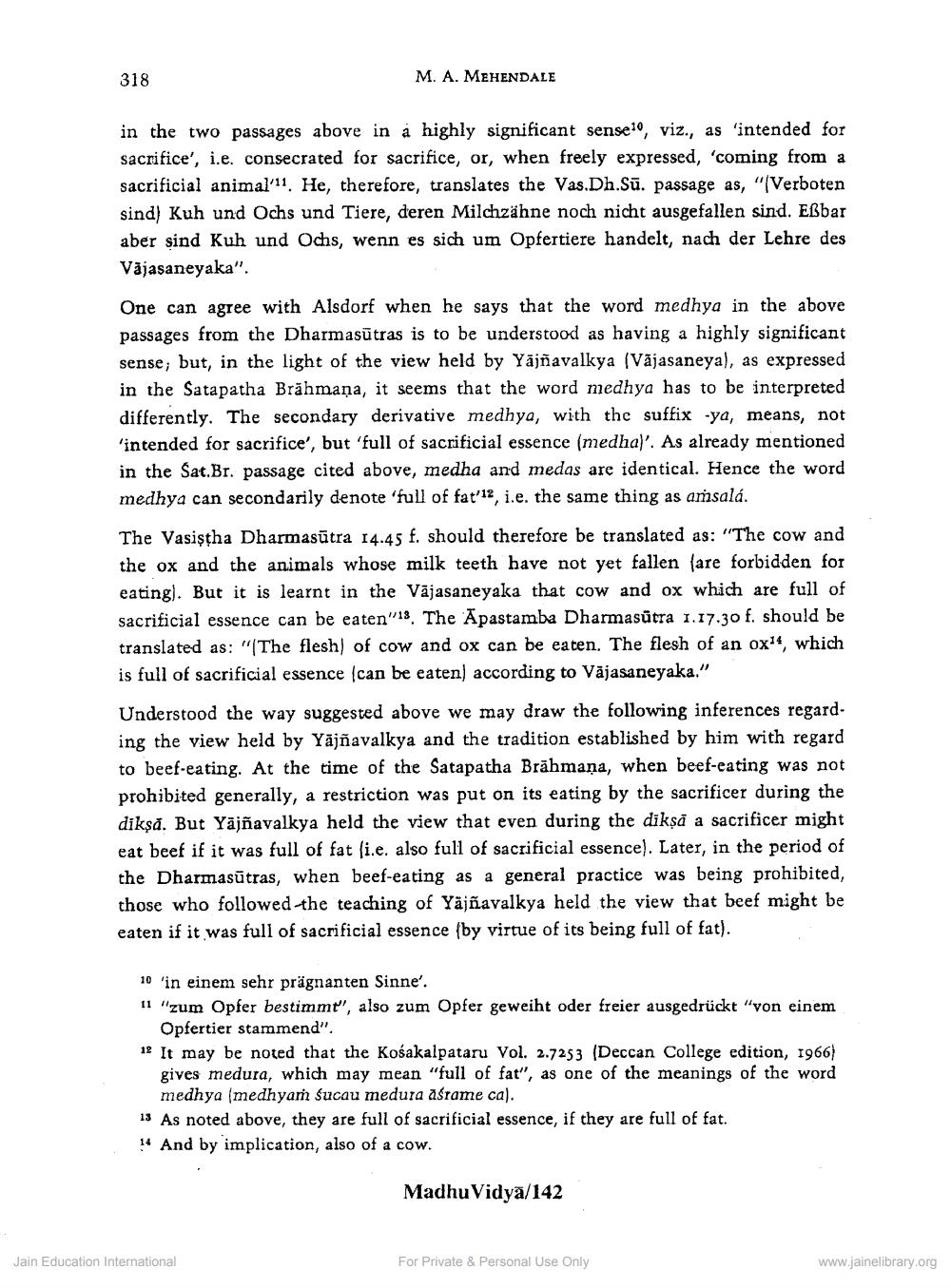________________
318
M. A. MEHENDALE
in the two passages above in a highly significant sense!, viz., as 'intended for sacrifice', i.e. consecrated for sacrifice, or, when freely expressed, 'coming from a sacrificial animal 1. He, therefore, translates the Vas.Dh.Sū. passage as, "Verboten sind) Kuh und Ochs und Tiere, deren Milchzähne noch nicht ausgefallen sind. Esbar aber sind Kuh und Ochs, wenn es sich um Opfertiere handelt, nach der Lehre des Vājasaneyaka". One can agree with Alsdorf when he says that the word medhya in the above passages from the Dharmasūtras is to be understood as having a highly significant sense; but, in the light of the view held by Yājñavalkya (Vājasaneya), as expressed in the Satapatha Brāhmaṇa, it seems that the word medhya has to be interpreted differently. The secondary derivative medhya, with the suffix ya, means, not 'intended for sacrifice', but ‘full of sacrificial essence (medha)'. As already mentioned in the Sat.Br. passage cited above, medha and medas are identical. Hence the word medhya can secondarily denote 'full of fat'12, i.e. the same thing as aṁsalá.
The Vasiştha Dharmasūtra 14.45 f. should therefore be translated as: "'The cow and the ox and the animals whose milk teeth have not yet fallen fare forbidden for eating). But it is learnt in the Vājasaneyaka that cow and ox which are full of sacrificial essence can be eaten" 18. The Apastamba Dharmasutra 1.17.30 f. should be translated as: "The flesh) of cow and ox can be eaten. The flesh of an ox, which is full of sacrificial essence (can be eaten) according to Vājasaneyaka." Understood the way suggested above we may draw the following inferences regarding the view held by Yājñavalkya and the tradition established by him with regard to beef-eating. At the time of the Satapatha Brāhmaṇa, when beef-eating was not prohibited generally, a restriction was put on its eating by the sacrificer during the dikşă. But Yājñavalkya held the view that even during the dikşă a sacrificer might eat beef if it was full of fat fi.e. also full of sacrificial essence). Later, in the period of the Dharmasūtras, when beef-eating as a general practice was being prohibited, those who followed the teaching of Yājñavalkya held the view that beef might be eaten if it was full of sacrificial essence (by virtue of its being full of fat).
10 'in einem sehr prägnanten Sinne'. 11 "zum Opfer bestimmt", also zum Opfer geweiht oder freier ausgedrückt "von einem
Opfertier stammend". 12 It may be noted that the Kośakalpataru Vol. 2.7253 (Deccan College edition, 1966)
gives medura, which may mean "full of fat", as one of the meanings of the word
medhya (medhyam Sucau medura aśrame ca). 13 As noted above, they are full of sacrificial essence, if they are full of fat. 14 And by implication, also of a cow.
Madhu Vidya/142
Jain Education International
For Private & Personal Use Only
www.jainelibrary.org




